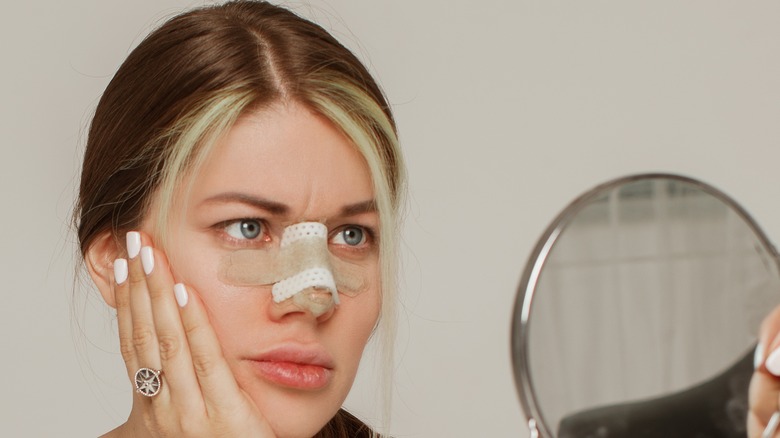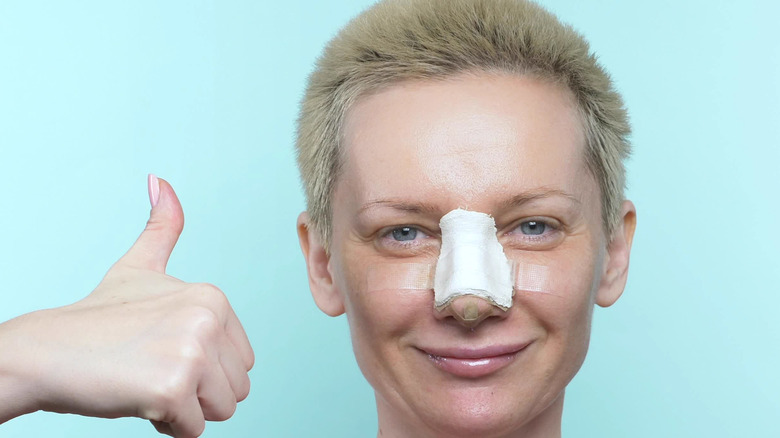What To Expect While Recovering From A Rhinoplasty
Colloquially called a nose job, rhinoplasty is a surgical procedure that alters the nose, according to the Mayo Clinic. Some people choose to pursue rhinoplasty for cosmetic reasons, while other people may have medical conditions that rhinoplasty can treat. Whatever the motivation for seeking rhinoplasty, it's a major surgical procedure, which can be deceiving since the nose is a small body part. Like any type of surgery, there is a recovery process, and knowing what to expect is the first step in making certain that you recover as quickly as possible.
The American Society of Plastic Surgeons reports that more than 300,000 people in the United States underwent rhinoplasty in 2020 alone. Rhinoplasty may be performed for many reasons, including reconstruction post-injury or accident, to improve a patient's ability to breathe, to relieve chronic sinus issues, to balance features, and to change the size, shape, and symmetry of the nose (per Mount Sinai). There are two types of rhinoplasty that can be performed. Primary rhinoplasty is a patient's first time undergoing the surgery to address breathing issues or to conduct cosmetic changes. Revision rhinoplasty serves to correct deformities or other issues arising from previous surgeries. Both types of rhinoplasty can be performed via open procedures where the incision is made at the base of the nose, which allows for grafting and complex restructuring. They can also be performed by closed procedures, where the surgical incisions are all made inside of the nose. All types of rhinoplasty require similar recovery.
What happens immediately after surgery
When you wake up from the anesthesia used to sedate you during the rhinoplasty procedure, you'll likely be in a recovery room and monitored by medical staff, according to the Mayo Clinic. Depending on your situation, you'll either be allowed to go home the same day or you may be kept in the hospital overnight. When you do leave the hospital, always have someone with you to help you get home. Once at home, stick only with medications approved by your doctor. Plan for approximately three weeks before you return to your normal schedule. Low-key activities, lots of rest, and plenty of fluids are key during this time.
During recovery, you'll likely have bandages or gauze set on your nose, says the American Society of Plastic Surgeons. The inside of your nose will also be splinted, and you may have stitches. Don't remove any bandages or protective items at home — wait for your doctor to remove them. Most bandages and splints are removed approximately one week after surgery during a post-operative appointment. For the first few weeks, you may notice black and blue swelling around your nose or under your eyes. This is completely normal and will go away in about two to three weeks. Realistically, it could take up to a year for the swelling to completely disappear and the full shape of your new nose to settle into place. Patience is paramount, but the end result should hopefully be worth it.
What to avoid while recovering
After having rhinoplasty, there are several things you'll want to avoid doing to ensure that your recovery is successful. For at least two weeks after surgery, don't take Advil, Motrin IB, or other medications that have ibuprofen or aspirin since there can be a risk of increased bleeding (via Mayo Clinic). Even though it may be difficult to avoid, don't blow your nose while recovering from rhinoplasty. Facial expressions like laughing and even smiling can interfere with your nose's healing as well. When brushing your teeth, do so gently and eschew movement of your upper lip. You'll also want to avoid wearing shirts that you have to pull over your head since they can interfere with the recovery of your nose. Instead, stick with button-down shirts or clothing that can be worn without going over your head.
Recovering from rhinoplasty is a good time to prioritize healthy habits. It's recommended that you eat foods high in fiber to avoid straining during bowel movements — this might cause you to make facial expressions, thus straining your nose, advises Mayo Clinic. Before your surgery, make a plan to eat vegetables and fruits during your recovery period, along with other high-fiber foods like chia seeds, chickpeas, lentils, and whole-wheat pasta (per Cleveland Clinic). For the first few weeks of your recovery, take it easy and refrain from strenuous exercises and cardio workouts.



